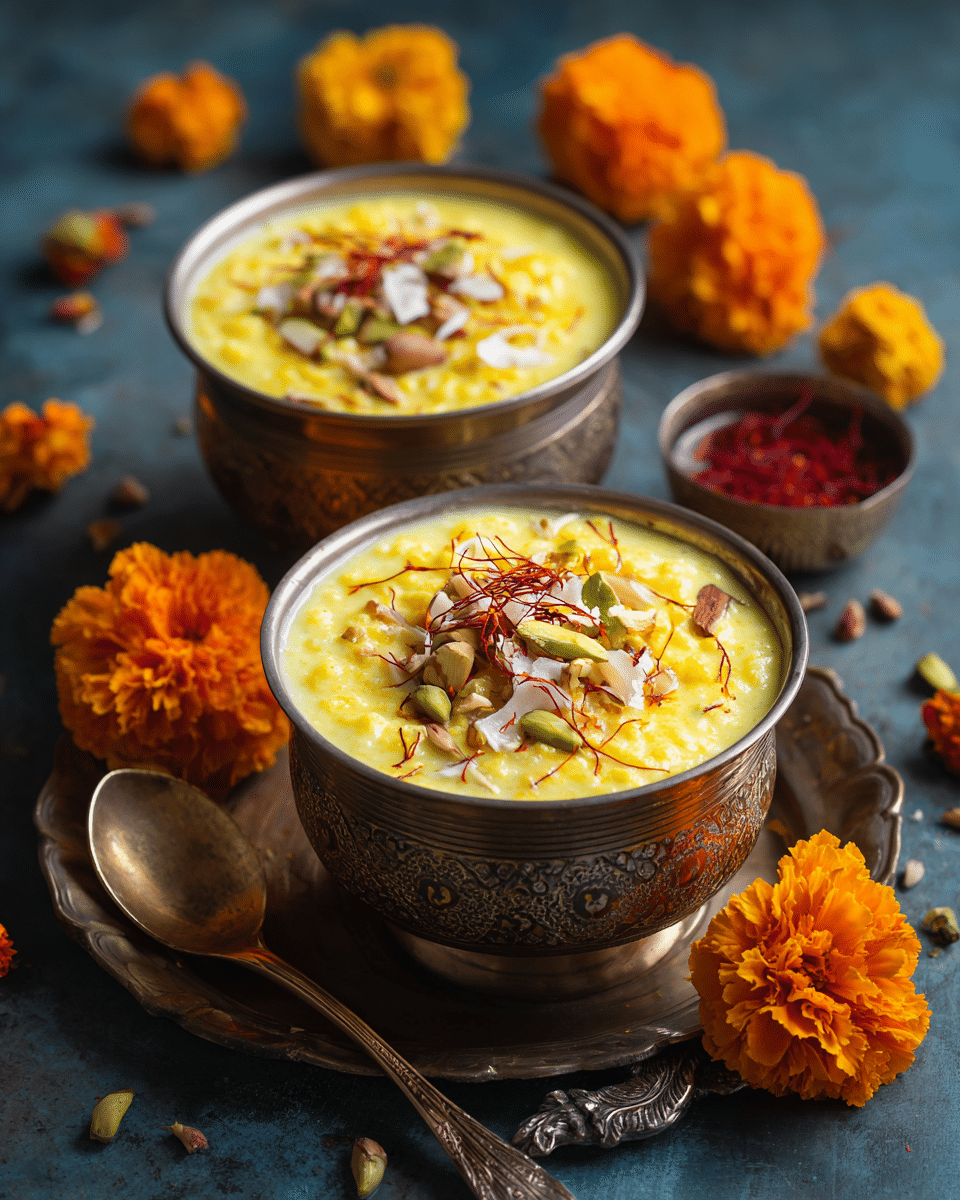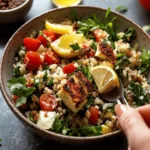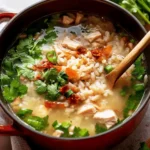Saffron Rice Kheer is a traditional Indian rice pudding, known for its luxurious texture and aromatic flavor. This festive dessert is typically prepared during celebrations and religious occasions, combining fragrant basmati rice, creamy milk, sweetened with sugar, and infused with cardamom and saffron. The delicate floral notes of saffron and the nutty garnish of almonds and pistachios elevate this dish into a decadent treat that’s rich yet comforting.
FULL RECIPE
Ingredients
- 1/4 cup basmati rice
- 4 cups whole milk
- 1/4 cup sugar (adjust to taste)
- 10–12 strands saffron
- 1/4 teaspoon cardamom powder
- 1 tablespoon sliced almonds
- 1 tablespoon chopped pistachios
- 1 tablespoon raisins (optional)
- 1 tablespoon ghee (optional, for richness)
- 2 tablespoons warm milk (for soaking saffron)
Directions
- Rinse the basmati rice thoroughly and soak it in water for 20–30 minutes. Drain before cooking.
- Soak the saffron strands in 2 tablespoons of warm milk and set aside.
- In a heavy-bottomed pan, bring the 4 cups of milk to a gentle boil over medium heat, stirring occasionally to prevent sticking.
- Add the soaked and drained rice to the boiling milk. Reduce the heat to low and simmer, stirring frequently to avoid burning.
- Cook the rice in the milk for 30–40 minutes, or until the grains are soft and the mixture thickens to a creamy consistency.
- Stir in the sugar and continue cooking for 5–7 minutes, allowing the sugar to dissolve completely.
- Add the saffron milk, cardamom powder, and optional ghee. Mix well and simmer for another 2–3 minutes.
- Stir in half of the almonds, pistachios, and raisins, reserving the rest for garnish.
- Turn off the heat and let the kheer sit for a few minutes to enhance the flavors.
- Serve warm or chilled, garnished with the remaining nuts and a few extra saffron strands if desired.
Nutrition Facts
- Calories: 210
- Total Fat: 8g
- Saturated Fat: 4.5g
- Cholesterol: 20mg
- Sodium: 70mg
- Total Carbohydrates: 28g
- Dietary Fiber: 1g
- Sugars: 16g
- Protein: 6g
- Calcium: 15% DV
- Iron: 4% DV
- Vitamin A: 6% DV
- Potassium: 180mg
Cultural Significance and Traditional Roots
Saffron Rice Kheer is a cherished dessert in Indian households, often prepared during festivals like Diwali, Eid, Holi, and religious ceremonies. Its deep cultural roots stem from centuries-old culinary traditions in South Asia, where rice and milk are seen as auspicious ingredients. Saffron, with its golden hue and luxurious aroma, symbolizes prosperity and purity. Kheer is more than just a dessert—it’s a celebratory offering, a comfort food, and a symbol of hospitality and festivity in many Indian homes.
Nutritional Benefits of Key Ingredients
Despite being a sweet treat, Saffron Rice Kheer offers nutritional benefits, especially when made with whole milk and natural ingredients. Milk provides calcium, protein, and essential vitamins like B12 and D. Basmati rice offers energy through complex carbohydrates, while nuts like almonds and pistachios supply healthy fats, fiber, and antioxidants. Saffron, though used in small amounts, contains powerful antioxidant compounds like crocin, which is linked to mood enhancement and potential health-promoting effects.
Role of Saffron in Flavor and Aroma
Saffron is the crown jewel of this dessert, responsible for its distinctive floral aroma and warm, golden color. This prized spice, derived from the stigma of the Crocus sativus flower, infuses the milk with a delicate yet unmistakable depth. Unlike artificial flavorings, saffron brings subtle complexity without overpowering the other elements. When soaked in warm milk before being added to the dish, saffron releases its full flavor potential and imparts a luxurious feel, making this kheer truly festive.
Achieving the Perfect Creamy Texture
The texture of Saffron Rice Kheer is one of its defining features—thick, rich, and velvety. Achieving this requires patience and slow cooking, allowing the milk to reduce and thicken naturally. Stirring frequently prevents the milk from sticking to the bottom and encourages starch release from the rice, which contributes to the pudding’s creamy consistency. The use of full-fat milk enhances richness, but even low-fat versions can yield a satisfying texture when simmered properly and long enough.
Customizations and Flavor Variations
While traditional Saffron Rice Kheer relies on a few classic ingredients, it is highly adaptable to different preferences and dietary needs. Coconut milk or almond milk can replace dairy for a vegan-friendly version. Adding rose water or kewra essence introduces a floral twist. Some regional adaptations include chopped dates, shredded coconut, or even grated carrots. The amount of sugar can be adjusted for sweetness, or replaced with jaggery, maple syrup, or stevia for healthier alternatives.
Serving Suggestions and Ideal Presentation
Saffron Rice Kheer can be served either warm or chilled, depending on the season and occasion. For a comforting winter dessert, it’s best enjoyed warm, while a chilled version makes for a refreshing summer treat. When serving guests, consider using small glass bowls or decorative cups to showcase the kheer’s golden hue and garnish it with slivered nuts and saffron threads for visual appeal. A light dusting of edible silver foil or dried rose petals can add an extra festive touch for special occasions.
Pairings with Other Festive Dishes
As a dessert, kheer pairs beautifully with traditional Indian meals, especially after a spicy or rich main course. It complements dishes like biryani, butter chicken, or paneer curry by offering a sweet counterbalance. For a festive spread, serve kheer alongside other Indian sweets like gulab jamun or jalebi, along with savory snacks like samosas or pakoras. A mild chai or a glass of sweet lassi also pairs well, enhancing the indulgent experience of the meal.
Storage and Shelf Life Tips
Kheer stores well in the refrigerator for up to three days when kept in an airtight container. Over time, it tends to thicken due to starch from the rice and absorption of liquid, so it’s advisable to add a few tablespoons of milk when reheating. Stirring over low heat will help bring back its creamy consistency. For longer storage, freezing is not recommended as it can negatively affect the texture, causing the milk to separate and rice to become grainy.
Using Leftover Kheer Creatively
If you find yourself with leftover Saffron Rice Kheer, there are several creative ways to repurpose it. Blend it slightly and use it as a filling for stuffed crepes or pancakes. Turn it into a frozen dessert by layering it into popsicle molds with fruit puree for saffron rice pudding popsicles. You can also mix it with a bit of flour and make a pancake-like batter for quick breakfast fritters. These ideas ensure no bit of this delicious dessert goes to waste.
Advertisement
Tips for Batch Cooking and Entertaining
Saffron Rice Kheer is an excellent make-ahead dessert for entertaining. It can be prepared in large quantities a day before an event, saving time on the day of celebration. Once cooled, portioning it into individual bowls or jars makes for easy serving during parties. For a buffet or potluck setting, you can keep it warm in a slow cooker or serve chilled in an ice bath. It’s a crowd-pleaser that appeals to both adults and children, making it a smart choice for gatherings.
Conclusion
Saffron Rice Kheer is a dessert that brings together tradition, elegance, and comfort in every spoonful. Its delicate balance of creamy richness and aromatic warmth has made it a favorite across generations and cultures. Whether you’re celebrating a festive occasion or simply indulging in a sweet treat at home, this dish offers more than just flavor—it offers connection, nostalgia, and joy.






